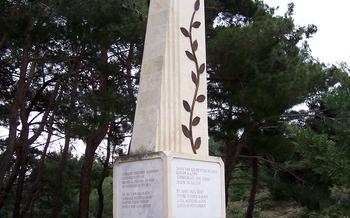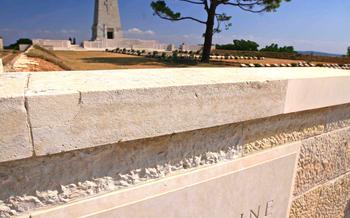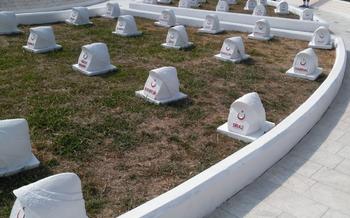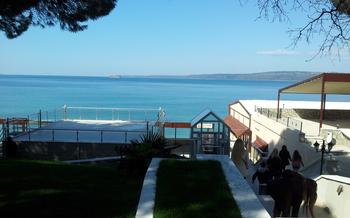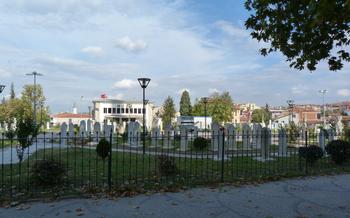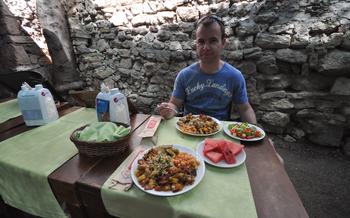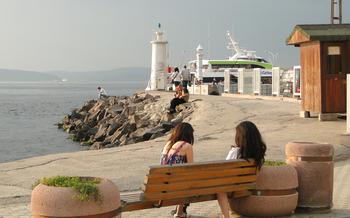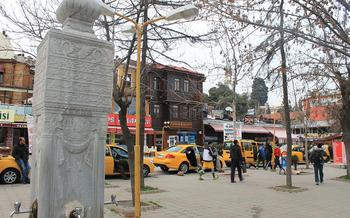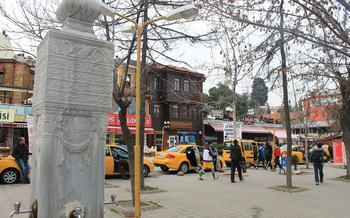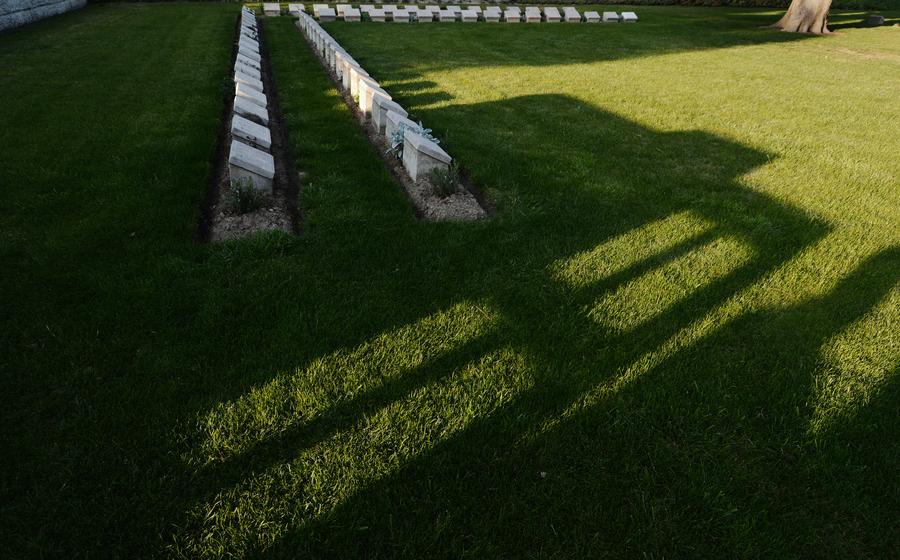
Gallipoli World War I Cemeteries
- History of Gallipoli
- The ANZAC Cove
- The Lone Pine Cemetery
- The Chunuk Bair Memorial
- The 57th Regiment Turkish Memorial
- The Nek Cemetery: A Silent Testimony to the Tragic Loss
- The Hill 60 Cemetery
- The Quinn's Post Cemetery
- Johnston's Jolly Cemetery
- The Beach Cemetery
- The Twelve Tree Copse Cemetery
- The Embarkation Pier Cemetery
- The Gallipoli Peninsula Historical National Park
- The Gallipoli Peace Park
- Insider Tip: Experience the ANZAC Spirit
History of Gallipoli
The Gallipoli Campaign, also known as the Dardanelles Campaign, was a military campaign of the First World War that took place on the Gallipoli Peninsula in the Ottoman Empire between April 1915 and January 191The campaign was fought between the Allied Powers, primarily the British Empire and France, and the Ottoman Empire. The campaign was a failure for the Allies, with over 500,000 casualties on both sides.
The campaign was conceived as a way to force the Ottoman Empire out of the war and to open up a supply route to Russia, which was being blockaded by the Ottoman Navy. The Allies landed troops on the Gallipoli Peninsula in April 1915, but they were unable to break through the Ottoman defenses. The campaign dragged on for months, with the Allies suffering heavy losses. In January 1916, the Allies finally evacuated their troops from Gallipoli.
The Gallipoli Campaign was a significant event in World War I. It was the first major defeat for the Allies, and it marked the end of the Ottoman Empire's involvement in the war. The campaign also had a profound impact on the people of Australia and New Zealand, who lost thousands of soldiers at Gallipoli. The campaign is still commemorated in both countries, and it is seen as a symbol of national sacrifice.
The ANZAC Cove
The ANZAC Cove, located at the southern end of the Gallipoli Peninsula, holds a significant place in the history of the World War I campaign. It was here that the Australian and New Zealand troops (ANZACs) landed on April 25, 1915, marking the beginning of the Gallipoli Campaign. The cove has become a sacred site, commemorating the courage and sacrifice of the ANZAC soldiers who fought and died on these shores.
The cove features several memorials and monuments that pay tribute to the ANZACs. Visitors can explore the ANZAC Commemorative Site, which includes the ANZAC Commemorative Walk, a series of bronze plaques that depict the landing and subsequent battles. The ANZAC Memorial stands as a poignant reminder of the fallen soldiers, with its simple inscription: "To the men of Australia and New Zealand who served and fell in the Dardanelles 1915-191"
The Lone Pine Cemetery, located nearby, is the final resting place for thousands of Australian soldiers who lost their lives during the Gallipoli Campaign. It is a solemn and moving place to remember the sacrifices made by these brave men.
The Lone Pine Cemetery
Amidst the poignant Gallipoli landscape, the Lone Pine Cemetery stands as a solemn tribute to the thousands of Australian soldiers who valiantly fought and sacrificed their lives in the Battle of Lone Pine. This hallowed ground, nestled amidst the rolling hills and rugged terrain, evokes a profound sense of remembrance and reflection.
The Lone Pine battle, fought in August 1915, was one of the most fiercely contested and costly engagements of the Gallipoli Campaign. Over the course of several days, Australian and Turkish forces engaged in a desperate struggle for control of the strategic Lone Pine ridge. The battleground, riddled with trenches, tunnels, and barbed wire entanglements, became a scene of immense carnage and devastation.
In the aftermath of the battle, the Lone Pine Cemetery was established as a final resting place for the countless Australian soldiers who fell in the conflict. The cemetery, meticulously maintained and adorned with rows of white headstones, exudes an atmosphere of serenity and reverence. Each headstone bears the name, rank, and unit of a fallen soldier, immortalizing their sacrifice and honoring their memory.
The Lone Pine Cemetery serves as a poignant reminder of the indomitable spirit and courage displayed by the Australian soldiers who fought at Gallipoli. Their selfless dedication and unwavering determination in the face of adversity continue to inspire and humble visitors who come to pay their respects.
The Chunuk Bair Memorial
The Chunuk Bair Memorial commemorates the New Zealand soldiers who fought at Chunuk Bair, a strategically important hill that was the scene of intense fighting during the Gallipoli Campaign. The memorial is located on the summit of the hill, which offers panoramic views of the surrounding battlefields.
The memorial was designed by New Zealand architect William Gummer and was unveiled in 192It features a bronze statue of a New Zealand soldier standing on a pedestal, surrounded by a circular wall inscribed with the names of the fallen. The statue is a poignant reminder of the sacrifice made by the New Zealand soldiers who fought at Gallipoli.
The Chunuk Bair Memorial is a place of great significance for New Zealanders. It is a place to remember the fallen and to pay tribute to the courage and sacrifice of the New Zealand soldiers who fought at Gallipoli. The memorial is also a reminder of the close ties between New Zealand and Turkey, and the shared history of the two countries.
The 57th Regiment Turkish Memorial
Amidst the sprawling Gallipoli Peninsula, where the echoes of World War I still linger, stands the 57th Regiment Turkish Memorial, a poignant tribute to the valiant soldiers of the Ottoman Empire who fought and sacrificed their lives in the defense of their homeland. This memorial holds immense significance not only as a commemoration of the Turkish troops' bravery but also as a symbol of the shared history between Turkey and the Allied nations.
Located in the heart of the Gallipoli battlefields, the 57th Regiment Turkish Memorial stands as a testament to the resilience and determination of the Turkish soldiers. It serves as a reminder of the fierce battles that unfolded on this land, where thousands of young men from both sides lost their lives in the pursuit of their respective ideals.
The memorial is a simple yet powerful structure, consisting of a series of white marble headstones arranged in neat rows. Each headstone bears the name, rank, and regiment of a fallen Turkish soldier, along with a brief inscription honoring their sacrifice. The serene atmosphere of the memorial invites visitors to pause and reflect on the immense loss and suffering endured by all those who fought in this tragic conflict.
The story of the 57th Regiment is particularly poignant. Comprising mostly young men from the Anatolian region of Turkey, they were among the first to engage in combat against the invading Allied forces. Throughout the campaign, they fought with unwavering courage and determination, despite facing overwhelming odds. The regiment suffered heavy casualties, with hundreds of its soldiers losing their lives in the defense of their homeland.
The 57th Regiment Turkish Memorial stands as a tribute to the bravery and sacrifice of these young men. It is a reminder that even in the midst of war, there is always room for remembrance and reconciliation. By honoring the fallen soldiers of both sides, the memorial promotes peace and understanding between Turkey and the Allied nations, ensuring that the lessons of Gallipoli are never forgotten.
The Nek Cemetery: A Silent Testimony to the Tragic Loss
Amidst the rolling hills of Gallipoli, the Nek Cemetery stands as a poignant reminder of the tragic events that unfolded during the ill-fated attack on the Nek. This small yet evocative cemetery is the final resting place for hundreds of Australian and Turkish soldiers who lost their lives in the fierce battle that took place on 7 August 19
The Nek, a strategically significant hilltop, became the focal point of a frontal assault launched by the Australian 3rd Brigade. Despite their valiant efforts, the Australian troops faced overwhelming resistance from the entrenched Turkish forces. The battle raged on for hours, with both sides suffering heavy casualties.
As the sun set on that fateful day, the Nek remained in Turkish hands. The battlefield was littered with the bodies of fallen soldiers, a testament to the horrors of war. In the aftermath of the battle, both sides worked tirelessly to recover the dead and provide them with a dignified burial.
The Nek Cemetery, meticulously maintained by the Commonwealth War Graves Commission, bears witness to the tremendous sacrifices made by the soldiers who fought at Gallipoli. Rows of white headstones, each inscribed with the name, rank, and regiment of the fallen, pay silent tribute to their selfless service.
Among the graves, the headstone of Lieutenant-Colonel William Malone stands out. Malone, a charismatic and respected officer, led the 3rd Battalion during the attack on the Nek. He was killed during the battle, and his grave became a symbol of the courage and determination displayed by the Australian troops.
The Nek Cemetery is a place of profound reflection and remembrance. It invites visitors to contemplate the futility of war and the immense suffering it inflicts on both sides. As you stand amidst the graves, you can't help but feel a sense of awe and gratitude for the sacrifices made by these young men who fought for their country.
The Hill 60 Cemetery
The Hill 60 Cemetery is a poignant reminder of the fierce fighting that took place at Hill 60 during the Gallipoli Campaign. This hill was a strategic position that was hotly contested by both sides. The British eventually captured the hill after a bloody battle, but they suffered heavy casualties. The cemetery is the final resting place for over 2,000 British soldiers who lost their lives in the battle.
The cemetery is located on the western slopes of Hill 60, overlooking the Dardanelles Strait. It is a peaceful and serene place, with well-maintained graves and memorials. The headstones bear the names of the fallen soldiers, as well as their ages and regiments. Many of the graves also have personal inscriptions from family members, expressing their grief and loss.
The Hill 60 Cemetery is a powerful reminder of the sacrifices made by the British soldiers who fought at Gallipoli. It is a place of reflection and remembrance, and it is an important part of the Gallipoli battlefields.
The Quinn's Post Cemetery
The Quinn's Post Cemetery is a poignant reminder of the fierce fighting that took place at Quinn's Post, a strategic hilltop that was the scene of intense battles between Australian and Turkish forces. The cemetery is the resting place of over 2,000 Australian and Turkish soldiers who lost their lives in the Battle of Quinn's Post.
The battle, which took place in August 1915, was one of the bloodiest and most costly of the Gallipoli campaign. After several failed attempts to capture the hill, the Australians eventually succeeded in taking it. However, they were unable to hold it for long, and it was eventually recaptured by the Turks.
The Quinn's Post Cemetery is a somber place that evokes the horrors of war. The headstones of the fallen soldiers stand in neat rows, each one representing a life lost. The cemetery is a reminder of the sacrifice made by both sides in the Gallipoli campaign, and it is a place where visitors can pay their respects to the brave men who fought and died here.
Johnston's Jolly Cemetery
Amidst the rolling hills of the Gallipoli Peninsula, nestled amidst the serene landscapes, lies the Johnston's Jolly Cemetery, a poignant reminder of the sacrifices made by British soldiers during the harrowing Gallipoli campaign. This hallowed ground serves as the final resting place for the brave men who fought with unwavering determination in the face of adversity.
The cemetery's name, "Johnston's Jolly," is a poignant tribute to Lieutenant-Colonel Charles George Johnston, who commanded the 1st Battalion of the Royal Munster Fusiliers during the Gallipoli campaign. Johnston, a beloved and respected leader, was known for his unwavering optimism and indomitable spirit, even in the face of overwhelming odds. His jovial nature earned him the affectionate nickname "Jolly" among his troops, a moniker that would forever be associated with this sacred site.
Established in 1915, the Johnston's Jolly Cemetery bears silent witness to the horrors of war and the immense sacrifices made by the British soldiers who fought in Gallipoli. The neatly aligned rows of headstones, each bearing the name and regimental details of a fallen soldier, create a solemn and deeply moving atmosphere. The meticulously maintained grounds, adorned with vibrant poppies and rosemary bushes, add a touch of beauty and serenity to this hallowed ground.
The cemetery holds a profound significance for the British people, serving as a poignant reminder of the courage and sacrifice displayed by their countrymen during the Gallipoli campaign. It is a place where families and friends can come to pay their respects, remember their loved ones, and honor their memory. The cemetery also serves as a valuable educational resource, providing visitors with a deeper understanding of the Gallipoli campaign and its far-reaching impact on British history.
As visitors wander through the Johnston's Jolly Cemetery, they are enveloped by a sense of peace and tranquility, a stark contrast to the fierce battles that once raged across these hallowed grounds. The serene atmosphere invites contemplation and reflection, allowing visitors to connect with the past and pay tribute to the fallen soldiers who made the ultimate sacrifice for their country.
The Beach Cemetery
The Beach Cemetery is situated near the beach at Gallipoli. It is the resting place for Allied soldiers who died during the campaign. The cemetery is a poignant reminder of the sacrifices made by the soldiers who fought in this brutal conflict. It is a place of great historical significance and a must-visit for anyone interested in the history of the Gallipoli Campaign.
The Beach Cemetery is home to over 2,000 graves of soldiers from Australia, New Zealand, the United Kingdom, France, and India. It is a serene place with rows of white headstones aligned in perfect order. The graves are adorned with flowers, wreaths, and other mementos left by family members and visitors.
The cemetery provides a stunning view of the Gallipoli Peninsula and the Aegean Sea. It is a place where visitors can reflect on the horrors of war and pay their respects to the fallen soldiers. The cemetery is a reminder of the futility of war and the importance of peace and reconciliation.
Insider Tip: Be sure to visit the Beach Cemetery during the evening when the sun is setting. The soft light of the sunset casts a beautiful glow on the cemetery and creates a truly moving experience.
The Twelve Tree Copse Cemetery
The Twelve Tree Copse Cemetery is a poignant reminder of the sacrifices made by British soldiers during the Gallipoli Campaign. Located near the village of Kabatepe, the cemetery is the final resting place for over 800 soldiers who lost their lives in the battle for Chunuk Bair.
The cemetery is named after a group of twelve trees that once stood on the site. These trees were used as a landmark by the British troops during the battle, and they became a symbol of hope and resilience. After the war, the trees were replanted in the cemetery, and they continue to stand as a reminder of the sacrifices made by the soldiers who fought and died at Gallipoli.
The Twelve Tree Copse Cemetery is a peaceful and reflective place, and it is a fitting tribute to the bravery and sacrifice of the British soldiers who fought at Gallipoli. The cemetery is open to the public, and it is a popular destination for visitors who want to learn more about the Gallipoli Campaign.
The Embarkation Pier Cemetery
The Embarkation Pier Cemetery is a poignant reminder of the sacrifices made by the Allied soldiers during the Gallipoli Campaign. Situated near the pier where the troops embarked for their ill-fated mission, the cemetery serves as a final resting place for those who never made it home.
Established in 1923, the cemetery is home to the graves of over 2,000 Allied soldiers, including Australians, New Zealanders, and British. Each grave is meticulously maintained, adorned with a simple white headstone that bears the soldier's name, rank, and unit. The atmosphere is one of profound respect and remembrance, a testament to the enduring legacy of the Gallipoli Campaign.
Among the most notable graves in the cemetery is that of Lieutenant Colonel William Malone, who commanded the 1st Battalion of the Royal Munster Fusiliers. Malone was killed in action on 29 April 1915, during the disastrous landing at V Beach. His grave is marked by an impressive Celtic cross, which stands as a symbol of the courage and sacrifice of the Irish soldiers who fought at Gallipoli.
The Embarkation Pier Cemetery is a poignant and evocative place, where visitors can pay their respects to the fallen soldiers of the Gallipoli Campaign. As you stand among the rows of white headstones, you can't help but be moved by the stories of sacrifice and heroism that lie beneath your feet.
The Gallipoli Peninsula Historical National Park
The Gallipoli Peninsula Historical National Park encompasses the battlefields and cemeteries of the Gallipoli Campaign. It was established in 1973 to protect and preserve the historical significance of the area. The park offers guided tours and educational programs to help visitors understand the events that took place here.
The park is home to a number of memorials and monuments dedicated to the soldiers who fought in the Gallipoli Campaign. These include the Anzac Cove Memorial, the Lone Pine Memorial, the Chunuk Bair Memorial, and the 57th Regiment Turkish Memorial. The park also includes a number of cemeteries where thousands of soldiers from both sides are buried.
The Gallipoli Peninsula Historical National Park is a place of great historical significance and a popular destination for visitors from around the world. It is a reminder of the sacrifices made by the soldiers who fought in the Gallipoli Campaign and a symbol of the peace and reconciliation that has been achieved between Turkey and the Allied nations.
The Gallipoli Peace Park
The Gallipoli Peace Park is a unique and poignant place that promotes peace and reconciliation between Turkey and the Allied nations, particularly Australia and New Zealand. Established in 2010, the park is located on the Gallipoli Peninsula, amidst the battlefields and cemeteries where thousands of soldiers lost their lives during World War I.
The park's mission is to foster understanding, compassion, and respect among people of all nations, especially the descendants of those who fought at Gallipoli. It offers educational programs, events, and exhibitions that shed light on the history of the campaign, the sacrifices made by the soldiers, and the importance of peace and reconciliation.
One of the highlights of the park is the Friendship Tree, which was planted in 2015 as a symbol of unity and peace between Turkey and Australia. The tree, a native of both countries, serves as a reminder of the shared history and the commitment to building a better future together.
The Gallipoli Peace Park is a powerful reminder that even amidst the devastation of war, peace is possible. It is a place where people can come together to learn from the past, honor the fallen, and work towards a future where peace and understanding prevail.
Insider Tip: Experience the ANZAC Spirit
To fully immerse yourself in the history and significance of Gallipoli, plan your visit to coincide with the annual Anzac Day commemorations, held on April 25th. This day holds immense importance for Australians and New Zealanders as they honor the memory of their fallen soldiers and the ANZAC spirit.
During this time, you'll witness moving ceremonies, including the Dawn Service at Lone Pine Cemetery, where thousands gather to pay their respects to the brave soldiers who fought and sacrificed their lives on these sacred grounds. The service commences before dawn, creating a uniquely poignant and solemn atmosphere.
Witnessing the ANZAC Day commemorations is a profoundly enriching experience that allows you to connect with the history of this hallowed place and appreciate the enduring legacy of the ANZACs. It's a chance to pay tribute to their bravery, resilience, and the indomitable spirit that continues to inspire generations.
